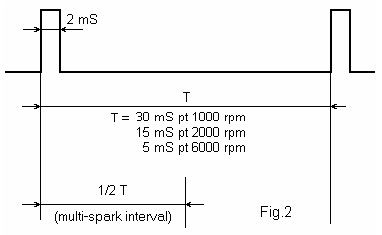|
Multi-spark ignition is very useful
especially in the case of startings at low temperature
and at low rpm range. Basic idea, is to apply to spark
plugs instead of only one spark, a spark-burst having
big energy. In this case, combustion of air/fuel mixture
is much better and the emissions are more reduced. In
addition, through burning improvement, the consumption
of fuel can be reduced.
Click Here to View Circuit
Why synchronized multi-spark, or what
means this?
Special literature abounds in
multi-spark EID schematics. These have in common the
fact, as the breaker-points dont control directly EID,
but an oscillator, which will generate a succession of
impulses, and these impulses shall command EID. This
aproach has two major deficiencies:
-
First spark doesnt match exactly
with the moment of breaking points; so, it has an
aleatory delay toward this. This is equivalent to an
aleatory modification of ignition advance, which
will leads to non-uniform run of engine.
-
At high rpm range, the time between
two impulses of multi-spark device can become
comparable with the time between breaker-points
impulses; this shall lead to an unstable operation
of engine, with trepidations and knockings. To avoid
this trouble, is necessary to switch-off the
multi-spark device when rpm of engine exceeds a
certain value.
With these in mind, I imagined the
device described forwards.
The crankshaft velocity of an internal
combustion engine is given by following formula:

where :
n = revolution speed of engine
crankshaft (rpm)
M = strokes number (2 or 4)
N = number of sparks per second (sparks
frequency, in Hz)
B = number of ignition coils
C = cylinder number
For usual four stroke engines, with 4
cylinders and a single ignition coil, the formula
becomes :

From where :


In fig.1 is shown an EID equipped with synchronized
multi-spark module.

Shaping block has the role to provide fixed length
impulses (2 mS) at each breaker-points opening. In this
way are eliminated the false impulses which appear due
contacts vibrations.
As shown in drawing, shaped impulse triggers directly
the EID and act as START impulse for multi-spark module.
If rpm of engine is under speed limit, the module will
generate a series of supplementary impulses that,
through an OR gate, will generate supplementary sparks
by EID. When speed limit is reached (for example, 2000
rpm), supplementary impulses stops at module output,
thus no supplementary sparks will be generated.
The module uses for control the shaped impulses from
breaker points. The time between two consecutively
impulses depends on rpm engine and has the values shown
in upper table.

From whole T interval, only in the first half of this
will be generated supplementary sparks, after the main
spark produced by the breaker points. This is very
important, because generating sparks outside of half of
the interval, the spinning distributor could apply these
sparks to next cylinder, and this could be very harmful
for mechanical parts of engine.
In fig. 3 is shown the block-diagram of the multi-spark
module.
At breaker-points opening, the shaping circuit (not
shown in drawing) produces a square impulse having 2 mS.
This, named BP, is applied to EID by an OR gate and
generate the main spark.
Click Here to View Circuit
In multi-spark module, during 2 mS interval, a sequence
timer (a counter with decoded outputs) accomplishes the
initialization of circuits (full operations will be
detailed later). When impulse BP disappears, the gate P2
is opened and the counter N1 receives impulses with 1 mS
period, from clock generator. This 8 bits counter
measures, in fact, the duration between two
breaker-points impulses. It can count maximum 255
impulses, each having 1 mS (see the table, this
correspond to 120 rpm, far below the free running speed
!). At next BP impulse, P2 close and the counting stop.
The number stored inside N1 is in fact the time length
between two BP impulses.
The sequence timer copy the number stored in N1 to N2,
after this resets counter N1. When BP becomes low level,
N1 restarts the counting. In the same time, the up/down
counter N2, starts counting the impulses having 0.5 mS
period, which comes via gate P1. It counts down, but
with double speed. In this way the counter N2 reach to 0
after T/2 time. The counter N4 and gate P5 makes the
impulses for supplementary sparks (2 mS length).
This counter works only if INH signal is at low level.
The fip-flop FF1 marks the interval T/2 in which will be
generated supplementary sparks. It is reseted when N2
reach 0. The gates P3 and P4 unlock the flio-flop and
start supplementary sparks. Also, these gates switch-off
the multi-spark function when engine speed limit is
reached (in this case, ~ 2000 rpm). How works this ? In
the upper table we can see at about 2000 rpm, the time
length between two BP impulses is 15 mS.
This means as after a counting cycle, the first 4 bits
of counter N1 will be 111 and next 4, 0000. In this
case, P3 gate output will be at low level, and the same
value for P4 output. The flip-flop FF1 will be not set,
and as result, no supplementary sparks. If the speed
engine decrease (time length T increase), the last 4
bits of N1 will have at least one 1 and the flip-flop
will be set. This allow to appear supplementary sparks
until flip-flop will be reseted by borrow impulse of N2.
|